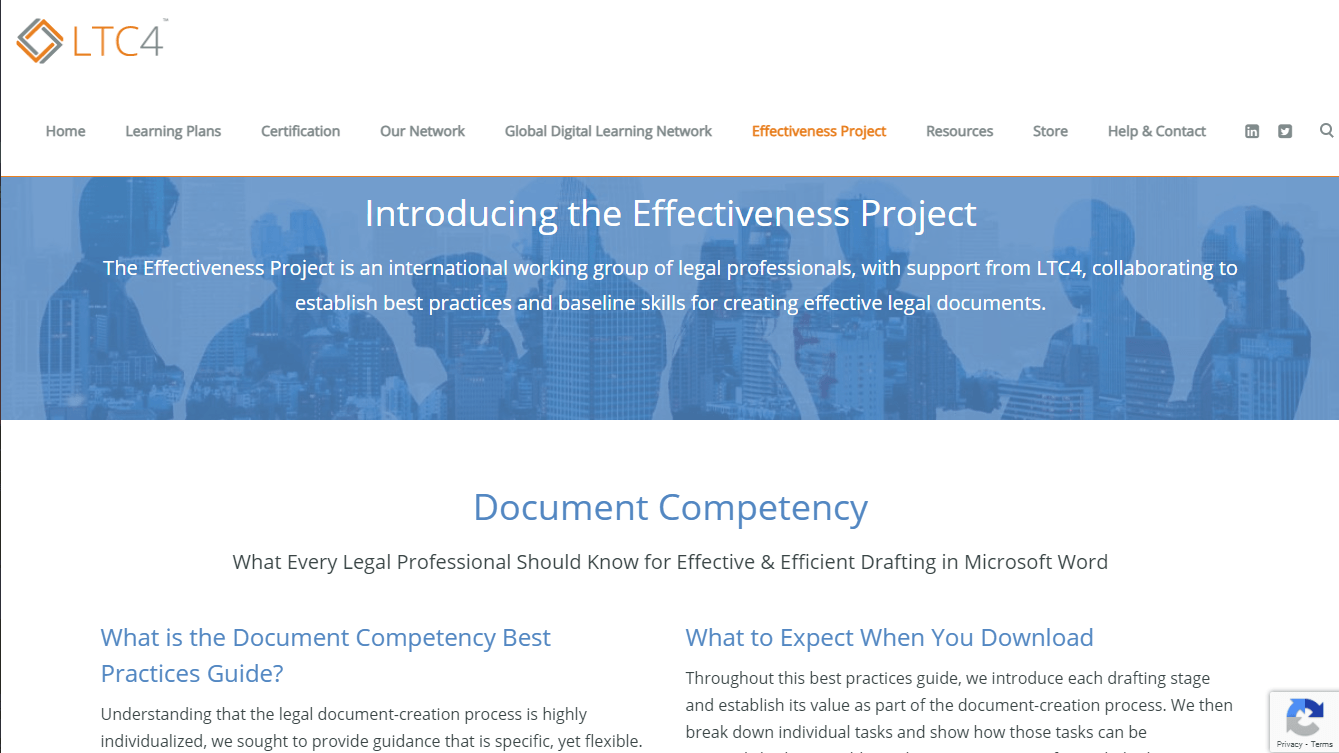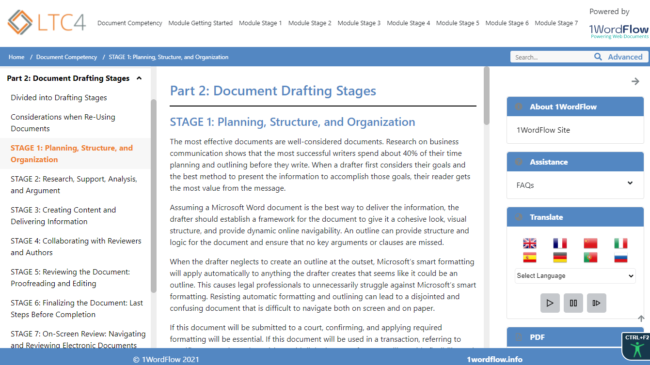An international working group of academics, vendors, lawyers and other legal professionals is today releasing the legal industry’s first comprehensive guide to best practices and workflows for creating effective legal documents in Microsoft Word.
Document Competency: What Every Legal Professional Should Know for Effective & Efficient Drafting in Word, is intended to establish for legal professionals “a baseline understanding for the document-creation work valued in the legal ecosystem, define parameters for the work, and set expectations for quality, effort, and result.”
It is the result of 18 months of work by the Effectiveness Project, an international team of experts working under the auspices of LTC4, the Legal Technology Core Competencies Certification Coalition.
The project was conceived and led by Ivy B. Grey, vice president of strategy and business development at WordRake, and co-led by Tony Gerdes, director of knowledge and innovation at Offit Kurman and a contributing member of LTC4.
“I was inspired to launch this project because I care deeply about the duty of technology competence and improving legal practice through simple, everyday technology like Microsoft Word,” Grey said. “By creating specific guidelines and focusing on a part of legal practice that everyone does, we can provide support for the technology competence mandate to have an impact.”
Sherry Kappel, a member of the Effectiveness Project team and an evangelist at Litera, said the team hoped to prompt legal professionals to think critically about every aspect of the document-creation process.
“Expectations for document creation are evolving,” Kappel said. “Legal service providers who efficiently use Microsoft Word and embrace its power will consistently and predictably create better documents. I believe this project will help.”
Others involved in developing the guide were: Rachel Baiden, global technology training manager, Squire Patton Boggs; Adrian Bailey, chief architect, DocStyle; Chris Cangero, chief executive officer, DocStyle; Dave DiCicco, senior director of product management, LexisNexis; Florentina Field, cofounder of Prelimine and litigation attorney at Quinn Emanuel; Jacob Field, cofounder of Prelimine; Colin Levy, legal tech evangelist and blogger; and Dyane L. O’Leary, associate professor of legal writing and director, legal innovation and technology concentration, Suffolk University Law School.
Seven Stages of Drafting
The guide is available through the Effectiveness Project website in three formats: interactive web pages, full downloadable PDF, and stand-alone modules organized by drafting stage.
The guide divides the document-drafting process into seven stages:
- Planning, structure, and organization.
- Research, support, analysis, and argument.
- Creating content and delivering information.
- Collaborating with reviewers and authors.
- Reviewing, editing, and proofreading.
- Finalizing the document.
- On-screen review.
It also discusses considerations to take into account when re-using previously drafted documents to create new ones.
For each stage, the guide provides a conceptual framework of what is accomplished at that stage and why it is important to the overall process. It then breaks down specific tasks appropriate to that stage, and then provides practical guidance on how to accomplish those tasks using either Word’s native functionality or third-party products that work with Word.
Providing that practical guidance was a key goal of the project, Grey told me during a recent interview with her and Kappel.
“The practicality of it was super-important to me,” she said. “We tell you what to do, we tell you why it’s important, we give you ways to be competent without having to go out and buy something new. Then we tell you how to take it to the next level, so that you can be a superstar.”
For example, at stage 3, creating content and delivering information, the guide begins with a conceptual overview discussing how to deliver information in a readable and logical manner. It then outlines the tasks that are central to this phase.
These include reviewing legal authority and integrating properly formatted citations, formatting the document and creating tables of contents and authorities, making legal phrases consistent, and inserting and updating cross-references.
For each task, it then outlines how to accomplish them. With regard to creating the table of authorities, for example, it points to a Microsoft help article, but also provides links to products such as Best Authority, ezBriefs, and Lexis for Microsoft Office.
“The goal of this project is to shift the conversation from mere efficiency to effectiveness, so that we may challenge how we think about document creation in our industry,” said co-leader Gerdes. “LTC4 already has application-agnostic learning plans to encourage efficiency, so the focus on effectiveness provides the ideal complement to LTC4’s offerings.”
Developed Over 18 Months
Development of the guide started 18 months ago when all of the working group members gathered in a room and started to discuss and break down the drafting process.
They went through several rounds of drafts, peer review, and redrafts, incorporating the feedback they received.
The tools recommended in the guide are all ones that members of the team have used and vetted, and in most cases, also have a business relationship to, such as Grey to WordRake and Kappel to Litera. They also all integrate with and work within Word.
The Effectiveness Project will continue to refine this guide over time, Grey and Kappel told me, and may also create additional components and similar projects.
Bottom Line
Like all writing, legal writing is, at its core, a creative and fluid process. But it is also a mechanical process, subject to formulas, conventions and standards that dictate their organization, style and components. This guide recognizes those dualities of creativity and constriction.
“For legal professionals, the documents we create are the lasting evidence of the advice and counsel we give,” it says. “Our documents represent our substantive skill and reflect the quality of our thinking.”
At the same time, the guide says, and especially with regard to electronic documents, document quality must also take into account the attributes that enable navigation and online review. “Therefore, the technical creation and presentation of documents carries as much weight as the substance that went into them.”
This guide provides a framework for the totality of the document-creation process, both its creative and mechanical aspects, by breaking it down into its component parts and offering practical guidance for completing each part. To my mind, the result is not to constrain creativity, but to enhance effectiveness.
When I first read the guide, I could not help but think of it as the document-creation equivalent of the Electronic Discovery Reference Model, or EDRM, a framework developed by e-discovery experts to map the e-discovery process and thereby help professionals understand the workflows and tools they would need to get through the process from start to finish.
In the same sense, this guide provides a set of practical guideposts and suggestions of technology tools for drafting legal documents not just efficiently, but effectively.
Just as the EDRM has withstood the test of time and remains the guiding framework in e-discovery, I suspect this guide — although it is certain to evolve — will become the guiding framework in document drafting for years to come.
 Robert Ambrogi Blog
Robert Ambrogi Blog

